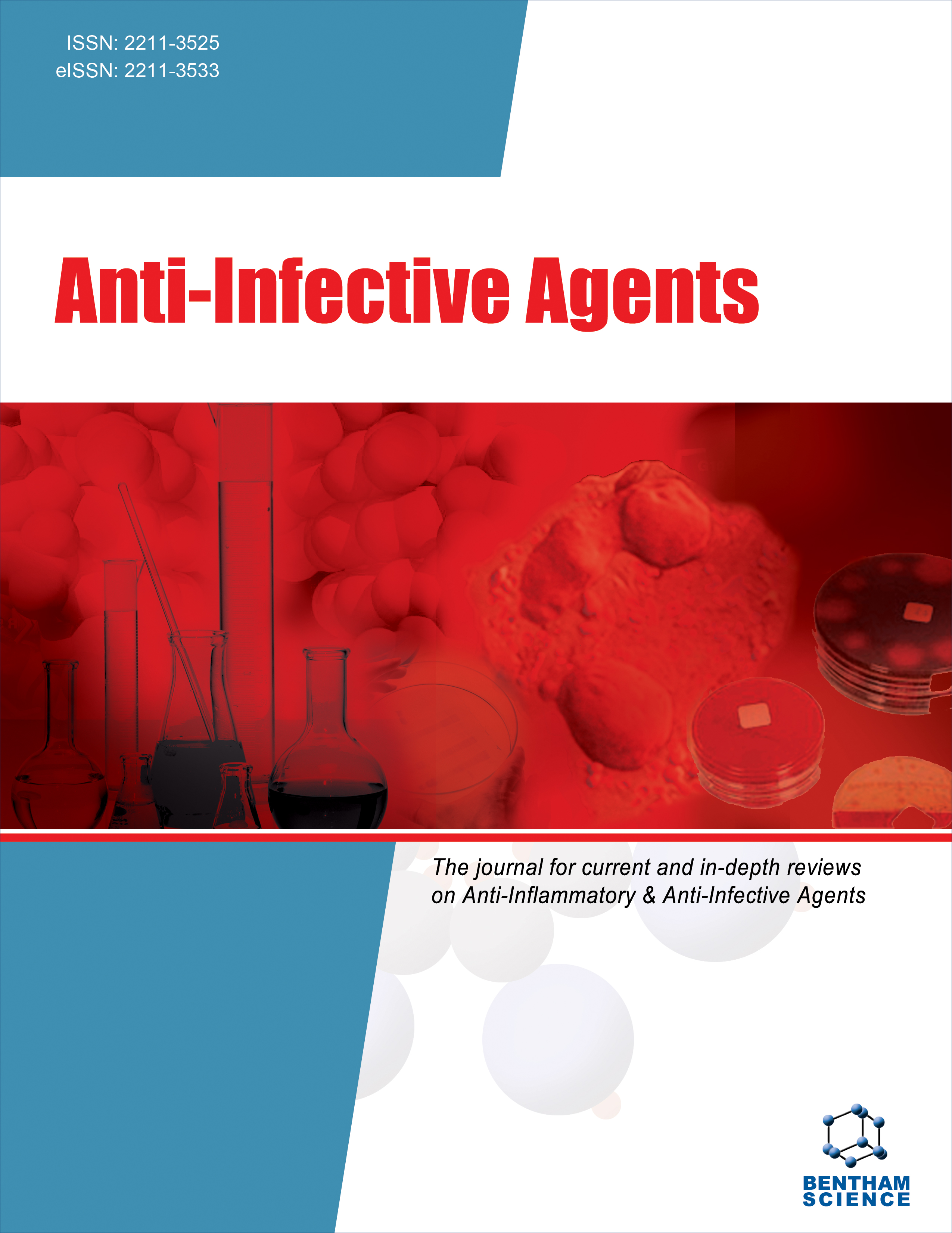- Home
- A-Z Publications
- Anti-Infective Agents
- Previous Issues
- Volume 14, Issue 1, 2016
Anti-Infective Agents - Volume 14, Issue 1, 2016
Volume 14, Issue 1, 2016
-
-
QSAR as a Random Event: Selecting of the Molecular Structure for Potential Anti-tuberculosis Agents
More LessAuthors: Andrey A. Toropov, Alla P. Toropova, Emilio Benfenati and Roberto FanelliBackground: Molecular structure is the basis for establishing of quantitative structure –activity relationships (QSARs). The molecular graph as well as the simplified molecular input line entry systems (SMILES) are possible ways to represent the molecular structure for QSAR analysis by means of the CORAL software. Methods: In spite of apparent influence of distribution of available data on the training set and validation set, the m Read More
-
-
-
A Review of Automatic Malaria Parasites Detection and Segmentation in Microscopic Images
More LessAuthors: Luís Rosado, José M. Correia da Costa, Dirk Elias and Jaime S. CardosoBackground: Malaria is a leading cause of death and disease in many developing countries, where young children and pregnant women are the most affected groups. In 2012, there were an estimated 207 million cases of malaria, which caused approximately 627 000 malaria deaths. Around 80% of malaria cases occur in Africa, where the lack of access to malaria diagnosis is largely due to a shortage of expertise, being the s Read More
-
-
-
Pre-Clinical Safety Evaluation of Antimicrobial Bioadhesive Vaginal Formulations
More LessAuthors: Mohd A. Alam, Farhan J. Ahmad, Zeenat I. Khan and Roop K. KharBackground: The mucosal formulations are required to be evaluated for their safety and irritability. In present study the safety and irritability potential of antimicrobial acid buffering bioadhesive vaginal (ABBV) products having a pH of 4.4 were investigated. Methods: Four groups of female rats were administered 0.1ml sham negative control, ABBV gel, ABBV tablet and suspension of marketed formulation, for 14 consecutiv Read More
-
-
-
Immune Response, Anaemia and Oxidative Stress in Trypanosoma brucei brucei Infected Rats Fed Vitamin E Supplemented Diet
More LessBackground: Tsetse-transmitted trypanosomosis remains a constant drain on the financial resources of African livestock keepers, on the productivity of their livestock and their health. Control involves tackling the parasite by treating livestock with trypanocides, or controlling the vector through insecticide-treated traps or cattle, aerial spraying, ground spraying, the sterile insect technique (SIT) or combinations of these. Read More
-
-
-
Better Antiretroviral Central Nervous System Penetration is Not Associated with Reduced Chronic Pain in People Living with Human Immunodeficiency Virus
More LessAuthors: Nathaniel M. Robbins, Kanokporn Chaiklang and Khuanchai SupparatpinyoObjective: To determine if better antiretroviral (ARV) central nervous system (CNS) penetration is associated with reduced rates of chronic pain in people living with HIV (PLWH). Background: Chronic pain remains prevalent in PLWH despite widespread ARV use. Mechanisms underlying this prevalence remain unknown, though neuroinflammation from persistent CNS HIV infection and maladaptive plastic changes in the CNS Read More
-
-
-
Synthesis and Anti-onchocercal Activity of Isonicotinoylhydrazones and their Copper(II) and Zinc(II) Complexes
More LessBackground: Onchocerciasis is one of the neglected tropical diseases with over 37 million persons affected and a risk population of over 120 million. Ivermectin, the only available drug for the treatment of onchocerciasis is microfilaricidal and there is no current drug effective against macrofilariae. The long duration of treatment of this parasite coupled with the emergence of resistance and the occurrence of severe si Read More
-
-
-
Design, Synthesis and Docking Study of Some Novel Isatin- Quinoline Hybrids as Potential Antitubercular Agents
More LessAuthors: Srinubabu Maddela and Ajitha MakulaBackground: Tuberculosis (TB) is the one which remains the world’s greatest public health challenges. Worldwide resurgence of TB is due to two major problems: the AIDS epidemic and the outbreak of multidrug resistant (MDR) TB. Thus, there is an urgent need to develop anti-TB drugs with enhanced activity against MDR strains. In the present study a hybrid pharmacophore based approach was used to design and synthesize Read More
-
-
-
Rational Design, Synthesis, Anti-HIV-1 RT and Anti-microbial Activity of Novel 2-(6,7-dimethoxy-3,4-dihydroisoquinolin-2(1H)-yl)-N-phenylpropanamide Derivatives
More LessBackground: AIDS continues to be a major public health issue worldwide. In 2014, an estimated 36.9 million people were living with HIV, in the same year, around 1.2 million people died due to AIDS-related illnesses. Due to global efforts particularly made in the last decade has reduced mortality rate due to AIDS and associated diseases. But still many people living with HIV/AIDS particularly in the low and middle income countries Read More
-
Most Read This Month
Article
content/journals/aia
Journal
10
5
false
en


